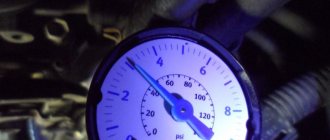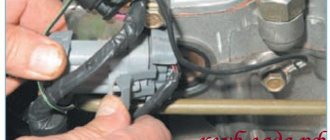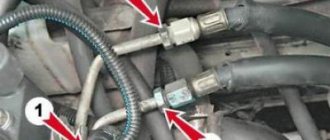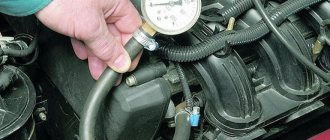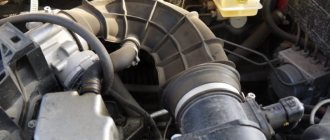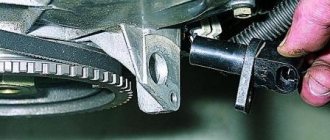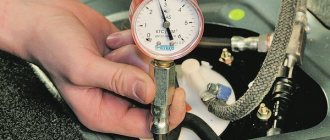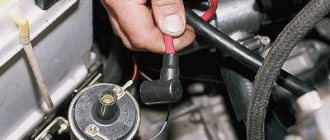Mechanical problems
First, you should check the throttle cable. Quite often it jams, and the pedal “sticks” when the driver has already removed his foot and the speed has not decreased. This may be due to the following problems:
- Corrosion of the cable
. At the same time, it simply gets stuck in the shirt; - Lubrication
. Sometimes drivers, in an effort to improve the operation of the unit, lubricate the cable; in winter, the lubricant freezes, which causes jamming; - Unsuccessful repair
. In some cases, after repairs, car owners incorrectly position the cable, resulting in problems.
Therefore, be sure to check the condition of the cable. See how it moves and replace it if necessary.
Preparing for measurements
We string a hose onto the inlet fitting of the pressure gauge and secure it with a clamp - we must avoid pressure losses during measurements.
Then you need to remove the cap from the fuel rail. There will be a nipple under it - remove that too. Be careful - if you recently started the car, there will be residual pressure in the fuel system and gasoline may spill out, so have a cloth ready and try to protect your eyes.
When you have removed the plug and nipple, install the second end of the hose that goes to the pressure gauge. We also fix everything with clamps.
Damage diagnostics
How to understand that an injector needs to be replaced, checked or repaired? Even without sensors, you can understand that repair of fuel system elements is required if there are 1 of 2 main signs in models 2107, 21074:
- Unstable engine operation. Sometimes it may stall or have difficulty starting.
- A much less obvious sign is loss of power. This effect is noticeable if you mostly drive at medium speeds, but at high speeds it is very noticeable.
- The last sign is recorded only by sensors - the pressure inside the system increases.
The cause of such failures is clogged injectors; even diagnostics are not needed. Cleaning helps restore the engine to its original performance. If the problem has not been resolved after cleaning, it is worth checking the tubes and injectors for damage or breakdowns. In such cases, it is better not to start repairs, but simply replace the damaged parts with new ones.
Sometimes it is impossible to determine on your own where the damage is, and only then will diagnostics at service centers come in handy. A blockage can cause quite serious damage to the VAZ 2107 injector, as well as rupture of channels. The pressure that arises inside the system can easily destroy the most fragile parts. Here you won’t be able to fix the situation with your own hands, even if you have a complete diagram of the car at hand. There is only one conclusion - you need to devote a lot of time and attention to cleaning injectors and do it regularly.
DTOZh replacement procedure and timing
The procedure for replacing the DTOZh may differ depending on the car model. At the VAZ, to carry out the process, you need to prepare several tools, including the obligatory set of wrenches.
According to the classic scenario, the coolant will have to be drained, otherwise replacing the DTOZH cannot be called correct. Although there are several replacement options that do not involve draining.
As mentioned above, one of the DTOZH is located in the thermostat. It screws in from the side. The second is located a little lower, wrapped in the cylinder head.
A little about the timing of replacement of DTOZH. If we are talking about a regulator that goes to the pointer, then it must be replaced at the very moment when the temperature values go astray. This is easy to check: for example, when the engine is cold, the coolant needle tends to the red zone or simply wanders. This is an error and requires correction, i.e., replacement of the sensor.
In some cases, it also happens that it is not the regulator itself that is to blame, but the wiring or contact. You need to check everything, and only then decide whether to change it or not. Testing the wiring is also easy: the wires are disconnected from the DTOZH, the ignition is turned on and a short to ground is made. If the arrow jumps up, then everything is in order with the wiring.
The second DTOZH changes if the machine itself is not working properly. For example, the speed of a cold engine does not increase, but when it is hot it reaches a value of 1500 rpm. Fault number 2 can also be judged by the cooling fan, which turns on too early or does not do so at all.
Temperature controllers that have been removed are easiest to check. They must be immersed in boiled water heated to certain values, then connect an ohmmeter to measure the resistance coming from the DTOZH.
Source
How to convert a VAZ 2107 carburetor engine to an injection engine
Some owners of carburetor “classics” independently convert their cars to an injector. Naturally, such work requires a certain amount of experience in auto mechanics, and knowledge in the field of electrical engineering cannot be done here.
What will you need to buy
The kit for converting a carburetor fuel system to an injection system includes:
- electronic control unit;
- gas tank;
- cylinder head (new or used from VAZ 21214);
- receiver;
- ramp with nozzles;
- fuel pump assembly;
- fuel filter;
- fuel line with rubber hoses;
- throttle assembly;
- accelerator pedal with cable;
- air filter assembly with sleeves;
- front engine cover;
- crankshaft pulley;
- ignition module;
- sensors for mass air flow, damper position, detonation, coolant temperature, oxygen concentration, crankshaft position, detonation;
- high voltage wires;
- harnesses, cables, wires, terminals, thermal casings;
- brackets.
The cost of all these elements is about 30 thousand rubles. The electronic control unit alone costs approximately 5–7 thousand. But costs can be significantly reduced if you buy used parts rather than new ones.
Conversion stages
The entire engine tuning process can be divided into the following stages:
- Removing all attachments: carburetor, air filter, intake and exhaust manifolds, distributor and ignition coil.
- Removing wiring and fuel lines. To avoid confusion when laying new wires, it is better to remove the old ones. The same should be done with the fuel pipes.
- Replacing the fuel tank.
- Replacing the cylinder head. You can, of course, leave the old “head”, but in this case you will have to bore the inlet windows, as well as drill holes and tap them for the receiver mounting studs.
- Replacing the front engine cover and crankshaft pulley. In place of the old cover, a new one is installed with a shimmer for the crankshaft position sensor. At this stage, the pulley also changes.
- Installation of the electronic control unit, ignition module.
- Laying a new fuel line with the installation of a return line, a fuel pump and a filter. The accelerator pedal and its cable are also replaced here.
- Installation of ramp, receiver, air filter.
- Installation of sensors.
- Laying wiring, connecting sensors and checking the functionality of the system.
It’s up to you to decide whether it’s worth spending time and money on conversion, but it’s probably much easier to buy a new injection engine, which costs about 60 thousand rubles. All that remains is to install it on your car, replace the gas tank and lay the fuel line.
Despite the fact that the design of an engine with an injection power system is much more complicated than a carburetor, it is very repairable. If you have at least a little experience and the necessary tools, you can easily restore its functionality without the involvement of specialists.
How to find a fault
You need to look for the cause of a fuel system malfunction in two directions: electrical and mechanical. The first option is diagnostics of sensors and their electrical circuits. The second is to check the pressure in the system, which will show how the fuel pump works and how gasoline flows to the injectors.
Error codes
It is recommended to start searching for any breakdown in an injection car by reading the error code issued by the electronic control unit, because most of the listed power system faults will be accompanied by a “CHECK” light on the dashboard. To do this, you can contact a service station, or carry out diagnostics yourself if you have a scanner designed for this. The table below shows error codes in the operation of the VAZ 2107 fuel system with their interpretation.
Table: error codes and their meaning
| Code | Decoding |
| R 0102 | Malfunction of the mass air flow sensor or its circuit |
| R 0122 | Malfunction of the throttle position sensor or its circuit |
| R 0130, R 0131, R 0132 | Lambda probe malfunction |
| P0171 | The mixture entering the cylinders is too lean |
| P0172 | Mixture too rich |
| R 0201 | Malfunctions in the operation of the injector of the first cylinder |
| R 0202 | Malfunctions in the operation of the injector of the second cylinder |
| R 0203 | Malfunctions in the operation of the injector of the third cylinder |
| R 0204 | Malfunctions in the operation of the fourth cylinder injector |
| R 0230 | The fuel pump is faulty or there is an open circuit |
| R 0363 | The fuel supply to the cylinders where misfires are recorded is turned off |
| R 0441, R 0444, R 0445 | Problems in the operation of the adsorber, purge valve |
| R 0506 | Malfunctions in the idle speed controller (low speed) |
| R 0507 | Malfunctions in the idle speed control (high speed) |
| P 1123 | Mixture too rich at idle |
| P 1124 | Idle mixture too lean |
| P 1127 | Too rich mixture under load |
| P 1128 | Too lean mixture under load |
Checking the rail pressure
As mentioned above, the operating pressure in the power system of the injection “seven” should be 2.8–3.2 bar. You can check whether it corresponds to these values using a special liquid pressure gauge. The device is connected to a fitting located on the fuel rail. Measurements are taken with the ignition on without starting the engine and with the power unit running. If the pressure is less than normal, the problem should be looked for in the fuel pump or fuel filter. It is also worth inspecting the fuel line pipes. They may be damaged or pinched.
A special liquid pressure gauge is used to check the pressure
Additional designations
The fuses of the VAZ 2107 car are located as follows:
- taillights and reversing lights;
- electric motor of the heater fan, headlight washer and glass wiper pumps;
- indicator for turning on the rear window heater VAZ 2107;
- direction indicators and hazard warning relays;
- fog lights;
- tachometer, voltmeter;
- control lamps for oil pressure, fluid, fuel level and reserve indicators on the instrument panel, instrument panel lighting;
- cigarette lighter and clock;
- VAZ sound signal;
- interior lighting (up to 2000 there was one lamp on the ceiling, for those manufactured after 2000 there were two lamps on the rear door pillars);
- high beam headlights;
- high beam warning lamp;
- engine compartment lighting and license plate lighting;
- glove compartment lighting;
- right headlight;
- left headlight.
PROMOTION: SALE OF NEW CAR 2022 PRODUCTION
We recommend watching:
- Fuel line diagram for VAZ 2110 injector
- Fuel pressure sensor VAZ 2107 injector
- What is the pressure in the fuel rail of the VAZ 2114
- Fuel rail Kalina 8 valves
- How to properly remove the adsorber VAZ 2107 injector
- How to replace the fuel filter on a Lada Priora
